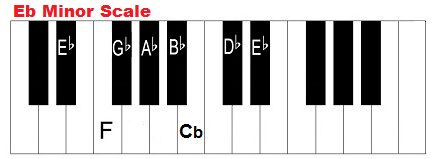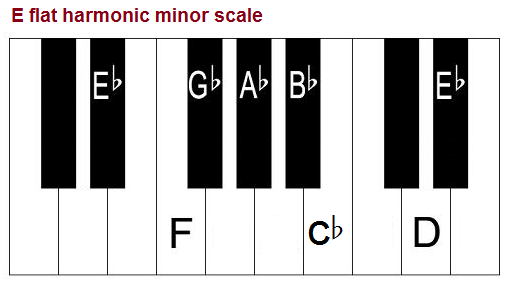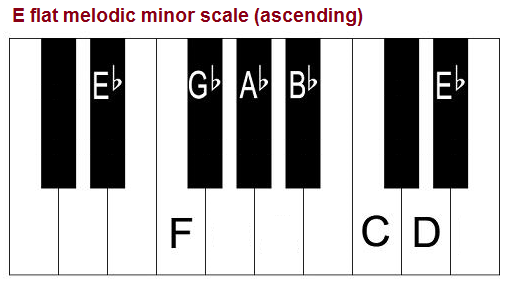In this lesson, we will learn how to play the E flat minor scale. The three types of minor scales are the natural, melodic and harmonic minor scales. We will take a look at all three of them here.
We will learn the notes, intervals and scale degrees of the E flat minor scale (natural, melodic and harmonic) on the piano, treble and bass clef.
E flat is an enharmonic of D sharp. On piano, the same keys are used to play the two scales. In terms of sound, they are identical. The only difference is the names of the notes. The notes of the D sharp natural minor scale are D♯, E♯, F♯, G♯, A♯, B, and C♯.
To learn more about this scale and others, check out my course, Learn Scales & Music Theory & Give Yourself An Upper Hand.
E Flat Natural Minor Scale
The notes of the E flat natural minor scale are E♭, F, G♭, A♭, B♭, C♭, and D♭. This scale has 6 flats.
Highly Recommended: Click here for the BEST piano/keyboard course I’ve come across online.
Let’s take a look at the intervals of the Eb minor scale.
- Tonic – The 1st note of the E-flat natural minor scale is Eb.
- Major 2nd – The 2nd note of the scale is F.
- Minor 3rd – The 3rd note of the scale is Gb.
- Perfect 4th – The 4th note of the scale is Ab.
- Perfect 5th – The 5th note of the scale is Bb.
- Minor 6th – The 6th note of the scale is Cb.
- Minor 7th – The 7th note of the scale is Db.
- Perfect 8th – The 8th note of the E-flat natural minor scale is Eb.
Here’s a diagram of the E flat minor scale on piano/keyboard.
Here’s the E flat natural minor scale on the treble clef.
Here’s the E flat natural minor scale on the bass clef.
How about the scale degrees? They are as follows:
- Tonic: Eb
- Supertonic: F
- Mediant: Gb
- Subdominant: Ab
- Dominant: Bb
- Submediant: Cb
- Subtonic: Db
- Octave: Eb
There’s a formula for forming natural minor scales using whole steps and half steps. That formula is W-H-W-W-H-W-W. “W” stands for whole step and “H” stands for half step.
Let’s form the E flat minor scale with this formula. Of course, our starting note is Eb. From Eb, we take a whole step to F. Next, we take a half step to Gb. From Gb, a whole step takes us to Ab. Another whole step takes us to Bb. From Bb, we go up a half step to Cb. From Cb, a whole step takes us to Db. Finally, the last whole step returns us to Eb.
The relative major key for the key of Eb minor is Gb major. A natural minor scale/key consists of the same notes as its relative major. The sixth note of the major scale becomes the root note of its relative minor.
Let’s now learn the piano fingerings for the Eb minor scale.
On both the left and right hands, the thumb is finger 1, index finger is finger two, middle finger is finger 3, ring finger is finger 4 and pinky (little) finger is finger 5.
- Notes of D sharp major scale: D#, E#, F#, G#, A#, B, C#, D#
- Notes of E flat major scale: E♭, F, G♭, A♭, B♭, C♭, D♭, E♭
- Fingerings (Left Hand): 2, 1, 4, 3, 2, 1, 3, 2
- Fingerings (Right Hand): 3, 1, 2, 3, 4, 1, 2, 3
Triad chords in the key of Eb minor and their notes:
- Chord i – E flat minor. Notes: Eb – Gb – Bb
- Chord iidim – F diminished. Notes: F – Ab – Cb
- Chord III – Gb major. Notes: Gb – Bb – Db
- Chord iv – Ab minor. Notes: Ab – Cb – Eb
- Chord v – Bb minor. Notes: Bb – Db – F
- Chord VI – Cb major. Notes: Cb – Eb – Gb
- Chord VII – Db major. Notes: Db – F – Ab
For further reading on the key of E flat minor and its chords, go here.
E Flat Harmonic Minor Scale
Now that we know the notes of the E flat minor scale (natural), we now take a look at the E flat harmonic minor scale.
To play a harmonic minor scale, you simply raise the seventh note of the natural minor scale by a half-step as you go up and down the scale. For example, the notes of the natural E flat minor scale are E♭, F, G♭, A♭, B♭, C♭, D♭, E♭. To form the E flat harmonic minor scale, we raise the seventh note by a half step and this results in E♭, F, G♭, A♭, B♭, C♭, D, E♭.
The formula for forming a harmonic minor scale is W-H-W-W-H-W 1/2-H. (Whole step – half step – whole step – whole step – half step – whole step and a 1/2 step – half step.)
Harmonic Minor Scale Intervals
- Tonic: The 1st note of the Eb harmonic minor scale is Eb.
- Major 2nd: The 2nd note of the scale is F.
- Minor 3rd: The 3rd note of the scale is Gb.
- Perfect 4th: The 4th note of the scale is Ab.
- Perfect 5th: The 5th note of the scale is Bb.
- Minor 6th: The 6th note of the scale is Cb.
- Major 7th: The 7th note of the scale is D.
- Perfect 8th: The 8th note of the Eb harmonic minor scale is Eb.
Here’s a diagram of the harmonic E flat minor scale on piano.
Here’s the E flat harmonic minor scale on the treble clef.
Here’s the E flat harmonic minor scale on the bass clef.
E Flat Melodic Minor Scale
Let’s now learn how to form the E flat melodic minor scale. While the harmonic minor scale raises only the seventh note of the natural minor scale by a half step, the melodic minor scale raises both the sixth and seventh notes by a half step.
The notes of the E flat natural minor scale (as we’ve seen) are E♭, F, G♭, A♭, B♭, C♭, D♭, E♭. For the E flat melodic minor scale we raise the 6th and 7th notes by a half step and this results inE♭, F, G♭, A♭, B♭, C, D, E♭. These notes are used when ascending. When descending, you go back to the natural minor scale.
Notes of the Eb melodic minor scale ascending: E♭, F, G♭, A♭, B♭, C, D, E♭.
Notes of the Eb melodic minor scale descending: E♭, F, G♭, A♭, B♭, C♭, D♭, E♭. (These are the notes of the Eb natural minor scale.)
The formula for a melodic minor scale (ascending) is W-H-W-W-W-W-H. The descending formula is the natural minor scale formula backwards.
Melodic E flat Minor Scale Intervals
- Tonic: The 1st note of the Eb melodic minor scale is Eb.
- Major 2nd: The 2nd note of the scale is F.
- Minor 3rd: The 3rd note of the scale is Gb.
- Perfect 4th: The 4th note of the scale is Ab.
- Perfect 5th: The 5th note is Bb.
- Major 6th: The 6th note is C.
- Major 7th: The 7th note is D.
- Perfect 8th: The 8th note of the Eb melodic minor scale is Eb.
Here’s the E-flat melodic minor scale on piano, ascending.
Here’s the E flat melodic minor scale on the treble clef. 
Here’s the scale on the bass clef. 
Learn how to build and play all types of scales.
Learn major and minor scales in all keys.
Here’s a course I highly recommend for everyone who’s learning to play piano and keyboard.
Home Page: Free Piano and Keyboard Lessons – Learn How To Play